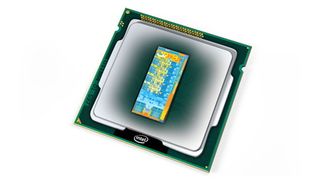Why you can trust TechRadar
When Intel launched the Nehalem generation of Core processors (like the heavyweight Core i7 980X), one of TechRadar's contacts deep inside the world's biggest chip maker told us it was all about fruit picking.
Bear with us.
What he meant was low-hanging fruit – the easy stuff. That meant moving the memory controller on-die and generally moving to a modern, high bandwidth processor architecture.
The result was a much faster processor than the Conroe chips it replaced.
Thing is, you only get the benefit of moving doing things like moving memory controllers on-die once.
So with the second generation Sandy Bridge architecture, it was all about the harder, finer detail work. And a very good job Intel did, too. In truth, the per-core performance of Sandy Bridge was well beyond anything we expected.
And so today we have Ivy Bridge, a die shrink rather than an all-new architecture.
And yet Intel is calling it the third generation Core architecture.

Well, the truth is, this Intel Core i7 770K is barely any faster than existing Sandy Bridge chips like the Core i7 2600K. Given how well optimised Sandy Bridge already is, that's not a surprise.
That said, we had hoped the new 22nm process would enable higher overclocks, much lower power consumption or maybe a bit of both. On this first viewing, it doesn't deliver much of either.
In fact, it's Ivy Bridge's graphics that Intel says justifies the "third generation" label, not the CPU cores. Fair enough, let's have a look.
The Intel Core i7 3770K gets the top HD Graphics 4000 core. With 16 execution units where the old Core i7s had but 12, you're looking at a third more hardware. Each unit has also been made more powerful and given DirectX 11 support.
The result is more performance, as much as 40 per cent more in our tests.

If that sounds impressive – and 40 per cent is a big increase – the problem is the starting point, which was well below what we'd call playable gaming performance. With the Ivy Bridge upgrade Intel has lifted graphics performance to what we'd now describe as barely tolerable.
The reality is that if you are remotely serious about games, you need a proper graphics card.
It's that simple.
As for the revised QuickSync video transcode core, it's roughly 10 per cent faster than before.
Which means it's ridiculously fast when it's working – about five times faster than encoding video on the CPU cores. But just like general purpose processing on AMD and NVIDIA's graphics chips, with limited software support it's always been had to get really excited about QuickSync. Ivy Bridge doesn't change that.
We liked
It's hard to imagine any desktop PC user ever needing more performance than the new Intel Core i7 3770K serves up.
On a per-core level, there isn't a faster processor available. And with four cores and eight threads, there's multi-threaded performance to burn.
The new HD Graphics 4000 core is a big step forward, too.
We disliked
As far as CPU performance, Ivy Bridge represents something of a stalling.
This is still a very fast CPU. It's just not much quicker than the processor it replaces. It's also not dramatically more power efficient and doesn't overclock any better.
Graphics aside, it's not a significant step forward.
Verdict
A quick chip, but Ivy Bridge is proof that Intel is no longer terribly interested in the desktop PC.
Contributor
Technology and cars. Increasingly the twain shall meet. Which is handy, because Jeremy (Twitter) is addicted to both. Long-time tech journalist, former editor of iCar magazine and incumbent car guru for T3 magazine, Jeremy reckons in-car technology is about to go thermonuclear. No, not exploding cars. That would be silly. And dangerous. But rather an explosive period of unprecedented innovation. Enjoy the ride.

Wear OS 5: what we want to see, and all the leaks so far

The obscure little PC that wanted to be a big NAS — super compact Maiyunda M1 doesn't cost that much, offers up to 40TB SSD storage, runs Windows and has 4 Gigabit Ethernet ports

Image site Abload going offline reminds me of how much online content we've permanently lost
